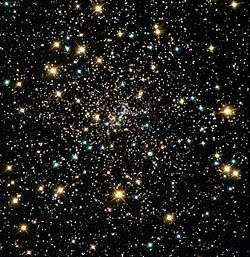NGC 6397
| NGC 6397 | |
|---|---|
|
| |
| Observation data (J2000 epoch) | |
| Class | IX[1] |
| Constellation | Ara |
| Right ascension | 17h 40m 42.09s[2] |
| Declination | –53° 40′ 27.6″[2] |
| Distance | 7.2 kly (2.2 kpc)[3] |
| Apparent magnitude (V) | +6.68[4] |
| Apparent dimensions (V) | 32′.0 |
| Physical characteristics | |
| Mass | 4.5×104[5] M☉ |
| Radius | 34 ly[6] |
| VHB | 14.2 |
| Metallicity | = –1.76[7] dex |
| Estimated age | 13.4 ± 0.8 Gyr[3] |
| Notable features | Second closest globular to Earth |
| Other designations | GCl 74,[4] Lacaille III.11, Dunlop 366, Bennett 98, Caldwell 86 |
NGC 6397, also known as Caldwell 86, is a globular cluster in the constellation Ara. It is located about 7,200 light-years from Earth, making it one of the two nearest globular clusters to Earth (the other one being Messier 4). The cluster contains around 400,000 stars,[3] and can be seen with the naked eye under good observing conditions.[8]
NGC 6397 is one of the at least 20 globular clusters of the Milky Way Galaxy that have undergone a core collapse,[3] meaning that the core has contracted to a very dense stellar agglomeration.
Astronomical research
Estimating the age of the Milky Way
In 2004, a team of astronomers[3] focused on the cluster to estimate the age of the Milky Way Galaxy. The team consisted of Luca Pasquini, Piercarlo Bonifacio, Sofia Randich, Daniele Galli, and Raffaele G. Gratton. They used the UV-Visual Echelle Spectrograph of the Very Large Telescope at Cerro Paranal to measure the beryllium content of two stars in the cluster. This allowed them to deduce the time elapsed between the rise of the first generation of stars in the entire Galaxy and the first generation of stars in the cluster. This, added to the estimated age of the stars in the cluster, gives an estimate for the age for the Galaxy: about 13.6 billion years, which is nearly as old as the universe itself.
Lower mass limit for stars
In 2006, a study of NGC6397 using the Hubble Space Telescope was published that showed a clear lower limit in the brightness of the cluster's population of faint stars. The authors deduce that this indicates a lower limit for the mass necessary for stars to develop a core capable of fusion: roughly 0.083 times the mass of the Sun.[9]
References
- ↑ Shapley, Harlow; Sawyer, Helen B. (August 1927), "A Classification of Globular Clusters", Harvard College Observatory Bulletin (849): 11–14, Bibcode:1927BHarO.849...11S.
- 1 2 Goldsbury, Ryan; et al. (December 2010), "The ACS Survey of Galactic Globular Clusters. X. New Determinations of Centers for 65 Clusters", The Astronomical Journal, 140 (6): 1830–1837, arXiv:1008.2755
 , Bibcode:2010AJ....140.1830G, doi:10.1088/0004-6256/140/6/1830.
, Bibcode:2010AJ....140.1830G, doi:10.1088/0004-6256/140/6/1830. - 1 2 3 4 5 "How Old is the Milky Way ?". Results for NGC 6397. Retrieved 2006-09-26.
- 1 2 "SIMBAD Astronomical Object Database". Results for NGC 6397. Retrieved 2006-11-16.
- ↑ Marks, Michael; Kroupa, Pavel (August 2010), "Initial conditions for globular clusters and assembly of the old globular cluster population of the Milky Way", Monthly Notices of the Royal Astronomical Society, 406 (3): 2000–2012, arXiv:1004.2255
 , Bibcode:2010MNRAS.406.2000M, doi:10.1111/j.1365-2966.2010.16813.x. Mass is from MPD on Table 1.
, Bibcode:2010MNRAS.406.2000M, doi:10.1111/j.1365-2966.2010.16813.x. Mass is from MPD on Table 1. - ↑ distance × sin( diameter_angle / 2 ) = ~34 ly. radius
- ↑ Forbes, Duncan A.; Bridges, Terry (May 2010), "Accreted versus in situ Milky Way globular clusters", Monthly Notices of the Royal Astronomical Society, 404 (3): 1203–1214, arXiv:1001.4289
 , Bibcode:2010MNRAS.404.1203F, doi:10.1111/j.1365-2966.2010.16373.x.
, Bibcode:2010MNRAS.404.1203F, doi:10.1111/j.1365-2966.2010.16373.x. - ↑ Dunlop, Storm (2005). Atlas of the Night Sky. Collins. ISBN 0-00-717223-0.
- ↑ "HST analysis of faint stars in NGC6397". Results for NGC 6397. Retrieved 2006-09-26.
External links
- NGC 6397 on WikiSky: DSS2, SDSS, GALEX, IRAS, Hydrogen α, X-Ray, Astrophoto, Sky Map, Articles and images
- NASA Astronomy Picture of the Day: Blue Stragglers in NGC 6397 (8 August 2003)
- NASA Astronomy Picture of the Day: Oddities of Star Cluster NGC 6397 (20 February 2002)
| Wikimedia Commons has media related to NGC 6397. |
